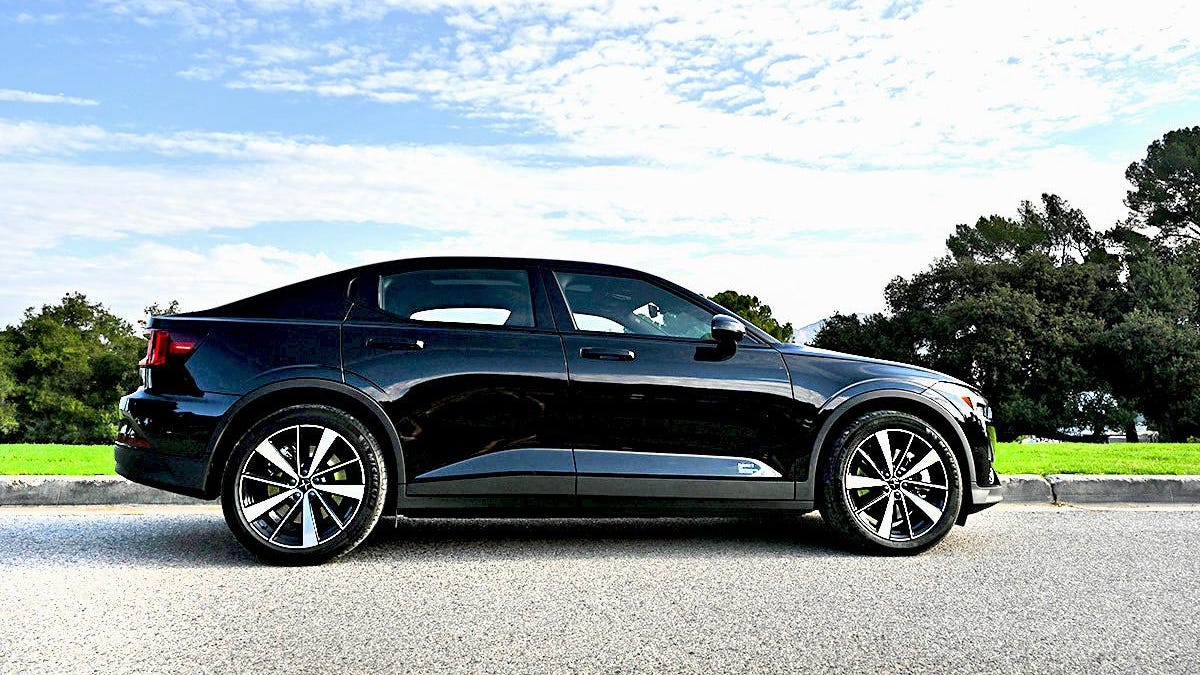Never heard of the Polestar? You’re not alone. Three different times during my test in Los Angeles – all of them while waiting for this zippy electric dynamo to fast-charge – passerby asked “What IS that?”
2022 Polestar 2
You can hardly blame them. Not only is the Polestar badge a baby when it comes to the current market, my black tester was indistinguishable from its neighboring vehicles in the lot where I picked it up around midnight. I had to click my key fob to see which set of headlights blinked to find it.
So, assuming you might not recognize the badge either, here’s a walkthrough of this fine ride with the funny name.
2022 Polestar 2
First, it’s a 4-door sedan with fastbackish characteristics. But it weighs a whoppin’ 4,397 pounds, which is what some SUVs weigh. It feels, however, light as a feather to drive.
The Polestar 2 starts at $49,900 and, with all options and delivery charge, it tops out at $58,400. You’ll get front-wheel drive with the single motor version with a range of about 270 miles, depending on your foot, of course. Go for the dual-motor – my tester – and your range dips, but you’ll also get all-wheel drive and a hell of a lot more punch.
As with most electrics, you take off like a silent shot, making it most enjoyable both around town and on the highway, rocketing you from a dead stop to 60 MPH in a scant 4 seconds. The dual motor trim also brings you an optional Performance package delivering forged 20-inch wheels with performance tires, adjustable dampers and upgraded Brembo brakes.
2022 Polestar 2
The handling is nice and sharp as well, and those brakes – sometimes a weak point of electrics – are mighty, and quick. What’s more, there are also three levels of regenerative braking – and one of them can stop the car without the driver even touching the brakes. This made buzzing around Mulholland drive a gas, er, a pleasure, sorry.
Select the Plus package and you’ll up the swank factor as well as receiving a mechanical heat pump that’ll increase your range by, it’s said, 10%. An over-the-air update will increase the dual-motor Polestar 2’s horsepower and pound-feet of torque from 408 to 476 and 487 to 502, respectively.
Polestar 2 steering wheel
You roll on a “Compact Modular Architecture,” aka CMA, same as sister company Volvo’s XC40. Your battery is a 75.0-kWh lithium-ion battery pack situated under the floor, and it’s capable of fast-charging up to 150 kilowatts. Polestar says you can recharge a dead battery to 80 percent in 40 minutes, good news indeed. It took me about 90 minutes to go from 17% to 85%, not horrible. Finding a pump near where I was staying was another magilla entirely, one I will devote a future article to. But we know this about electric cars. Unless you have a charger at your residence to plug into every night, you are at the mercy of whatever is out there near you when you need the juice.
The dual-motor version achieves around 89 MPGe, and in theory you’ll get 249 miles on a full charge.
Inside:
indoor polestar
The more I drove the Polestar 2, the more I liked its interior, which is unlike any other manufacturer’s. The lines are clean. The shift is a funny little loop-thing that you don’t even have to look at to find. The flavor is ultra-mod but muted, not obvious. You’ve got vegan fabric on the seats, although leather’s available should you want it.
Storage-wise, it’s measly in the rear cargo hold at 14 cubic feet, but open the “frunk” at the snout for extra space – one cubic foot.
technology
Polestar 2 Instrument cluster
I absolutely loved the Polestar 2’s 12.3 inch iPad-ish instrument cluster with its huge fonts and oh-so-obvious self-explanatory icons. Are you listening, Lexus? It took no time at all to sync my phone and the sound from the Harman/Kardon system was nice and crispy and loud.
And by the way, Polestar 2 was the first car in the world to feature an infotainment system powered by Google’s Android Automotive OS, with Google built-in. With Google Assistant, Google Maps and the Google Play Store integrated, you’re getting the top in voice-recognition and nav systems. I found the display directly ahead of my steering wheel rather homely, however.
2022 Polestar 2
A plus, though – the air quality system included in the Polestar 2 Plus pack detects pollutants and pollen and adjusts the passenger compartment filter to help keep them out. The car also makes “blinky” sounds to alert pedestrians to one’s presence.
Safety:
Safety features include standard blind spot monitoring, standard automated emergency braking with pedestrian detection and standard adaptive cruise control.
Warranty and Maintenance Coverage
A Limited warranty covers four years or 50,000 miles, electrical components are covered for eight years or 100,000 miles and, surprisingly, no complimentary scheduled maintenance is offered.
Again, this test got better and better as time went on and by the end I loved the body of the Polestar 2, and its drive. Check your options, of course, but if you want something truly unique-looking that delivers everything anyone ever liked about electric vehicles, this is a fine choice indeed.
2022 Polestar 2
From the company: “From 2022, Polestar plans to launch one new electric vehicle per year, starting with Polestar 3 – the company’s first electric performance SUV which is expected to debut in October 2022. Polestar 4 is expected to follow in 2023, a smaller electric performance SUV coupe.”
.


